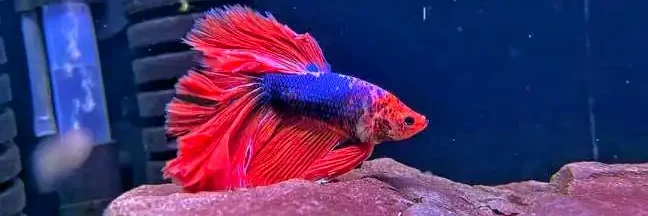Table of Contents
Types of Betta Fish
When you’re buying a betta fish from a store for the first time, it can be overwhelming to choose from the various head and tail types, colors, and patterns available. Siamese fighting fish are beloved pets for their vivid colors and elegant fins, attracting both enthusiasts and spectators.
Initially, there were fewer betta fish species in the wild than you’ll find in pet stores today. Store owners and professional breeders have selectively bred them to produce betta fish of desired colors, shapes, and patterns. They follow the standards set by the International Betta Congress (IBC) for each betta fish category and type.
Point to Remember
Before going into the details of various betta fish types, it’s important to understand that betta fish don’t have distinct breeds, but rather, they are described based on a combination of traits such as body color, fin size, and shape. For example, a betta with both crown tail fin shape and the dalmatian mutation is called a crown tail dalmatian betta. Similarly, a betta with a halfmoon fin shape and the rosetail mutation is termed a halfmoon rosetail.
Genetics Behind the Beauty
Ever wonder why bettas come in so many colors and tail types? It all comes down to genetics. Just like in people, bettas inherit traits from their parents—some are dominant (they show up more easily), while others are recessive (they might stay hidden unless both parents carry them).
For example, a betta might have the gene for a Halfmoon tail, but if it’s recessive and the other parent doesn’t carry it, the tail won’t appear in their babies. Over the years, breeders have carefully chosen which bettas to pair, selecting for traits like color, fin shape, and even personality.
That’s why we now see such an incredible range—from metallic sheens to butterfly patterns. It’s not just luck—it’s science and dedication at work!
Betta Fish Anatomy

Why Knowing Betta Types Matters?
Understanding the different types of bettas helps hobbyists recognize what kind they have, how to care for them properly, and whether they’re a good fit for their tank. Some bettas may need more space, have different temperaments, or require special care—so knowing the type makes it easier to keep them healthy and happy.
Beware of Betta Mislabeling
Not all that glitters is a true betta type. When buying a betta, it’s important to be aware that many sellers mislabel their bettas with multiple types to attract more interest.
This can make it confusing to accurately identify and differentiate between the various fin and color types. The pet store breeders might neglect the care of betta fish, focusing solely on the fish’s appearance during breeding.
By the end of this guide, you’ll be able to identify the most common types of betta fish that are popular in the aquarium hobby and will not be misled by sellers’ mislabeling. You’ll also be able to confidently identify various betta tail shapes, colors, and patterns.
Types of Betta Fish Based on Fin-categories
Betta fish have been categorized into two groups based on fin type.
One is long-finned betta fish and other is short-finned betta fish.
Long-finned Categories
1. Veil Tail (VT)
The veiltail betta is one of the oldest domesticated betta species and remains popular among betta enthusiasts due to its affordability. Its name is derived from the veil, a piece of cloth used in Eastern countries to cover the head and shoulders.
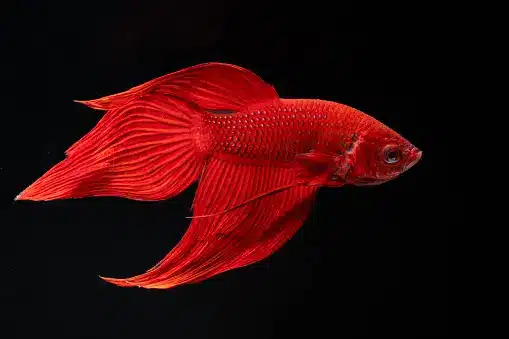
The type of betta fish has long, flowing caudal (tail) fins that arch slightly and hang like a veil, exhibiting a mesmerizing appearance. The fins start with a bulbous base, round from both sides and taper to a pointed tip. The dorsal fins are longer and slimmer compared to the anal fins, which originate from the entire underside of the betta’s body, and end in a tapered point.
Female veiltail bettas do not have as much bulbous base as males; their fins are elongated throughout. Veiltail bettas come in many colors, ranging from dark red to soft blue.
Though veil tails are tolerant to diseases, their long fins can still be prone to fin rot or tearing in poor conditions or with sharp decor.
2. Crown Tail (CT)
The crown tail betta is one of the most distinctive types of betta fish, easily recognized by its unique fin appearance. All of its fins-caudal, dorsal, and anal-extend beyond the membrane in the form of rays with sharp edges, creating a crown-like appearance. The caudal fins of the crown tail betta might split into two or more rays at the tips, resulting in single ray (SCT) or double (DCT), which gives the fish a more jagged look.
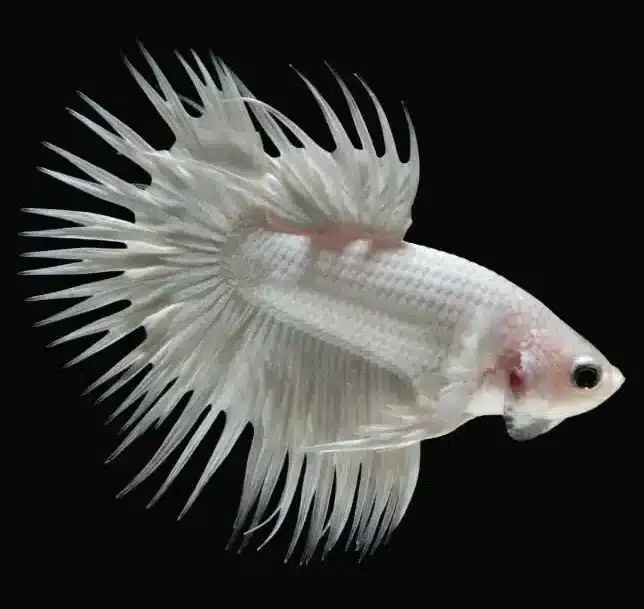
In female crown tail bettas, the caudal fins are more extended compared to the dorsal and anal fins. They are pretty cute and have distinct personalities. Crown tail bettas are not very friendly and remain inactive most of the time. These betta types are more prone to fin nipping from tank mates. So, ensure pristine water to prevent fin rot in the exposed fin rays
3. Halfmoon (HM)
The halfmoon is considered one of the most beautiful betta fish in the aquarium hobby. It was the most sold-out betta when I was working at a pet store. Honestly speaking, it’s my favorite personal.
The halfmoon betta has caudal fins that spread straight in the shape of a half-circle over 180 degrees, resembling a half-moon when fully flared. Its straight anal fins extend along the entire underside of the betta, touching the edges of the tail fins. Halfmoon dorsal fins originate from the middle of the betta’s back and are long and slightly curved. This impressive fin display gives it a very large and lush appearance, making it popular among breeders and betta lovers.
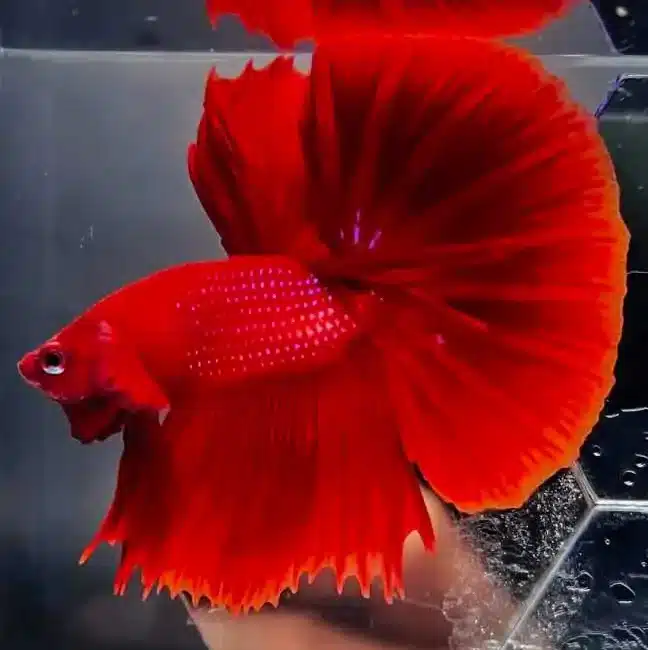
Halfmoon betta remains active and is considered intelligent, making it a great option for fish hobbyists. They are sub-categorized based on color, patterns, and fin shape, such as Dumbo halfmoon, White halfmoon, and Halfmoon butterfly.
Female halfmoons have long, heavily branched caudal and anal fins compared to male halfmoon. Their long fins in both males and females can be heavy, potentially impacting swimming. Their fins are prone to fin damage; require low-flow filters and smooth decorations.
4. Delta Tail (DT)
Delta tail has earned its name because of its triangular-shaped caudal tail, which doesn’t reach a full 180-degree, like the halfmoon. Their tail fin spread is less than 135 degrees but fans out wider than a veiltail.
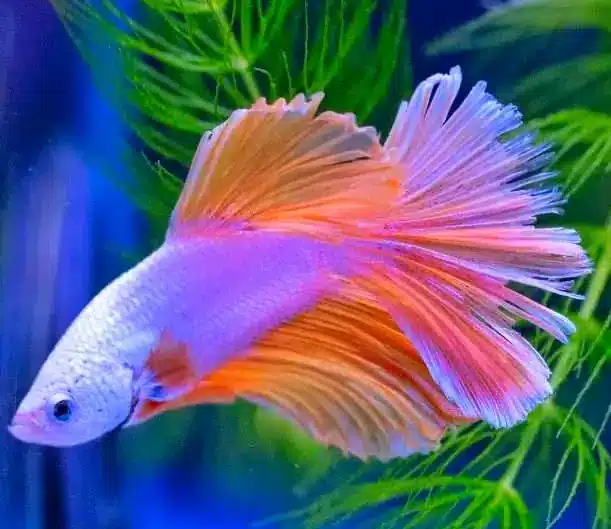
The caudal fins of the delta tail betta are very large, with straight edges that are wider at the ends and narrow as they reach the dorsal part. Its dorsal and anal fins are almost the same as those of the halfmoon betta. These fish require a standard care of the betta fish.
5. Super Delta Tail (SDT)
Super Delta tail bettas are known for their beautiful, flowing tails that spread out between 135 to 180 degrees—not quite as wide as a halfmoon, but still very eye-catching. Their fins are large and elegant, giving them a graceful look when they swim.
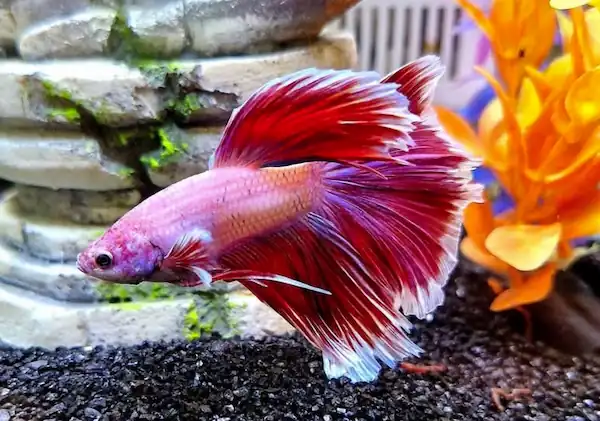
Because of their long fins, they need clean water and a calm tank setup to avoid tearing. They’re pretty common and easy to find, making them a great choice for anyone who wants a striking betta without needing anything too fancy.
6. Double Tail (DT)
Double tail bettas are selectively bred from halfmoon bettas with a genetic mutation that characterizes their tail fins with two distinct lobes. Their caudal fins look like they have been split into two lobes, showing different bifurcation. Double tail bettas often have broader anal fins. Female double tail bettas are similar to males but with slightly longer dorsal fins.
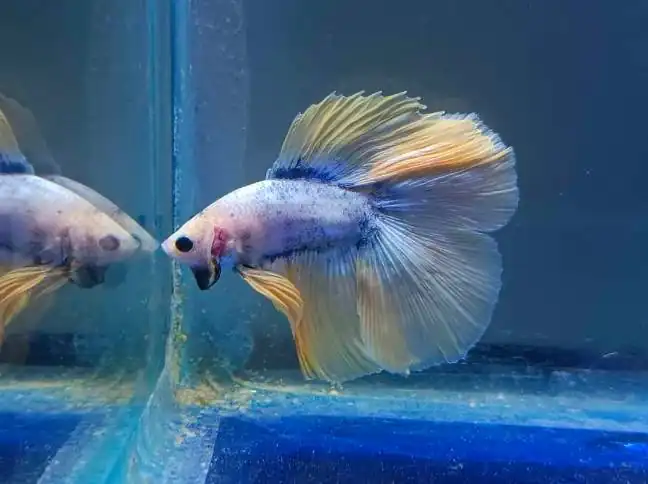
Most breeders selectively breed two double tail bettas, which can result in triple caudal fins or tail deformities, making bettas more prone to swim bladder disease. They can also be paired with other fin types (e.g., Double Tail Halfmoon). Besides SBD, double tail bettas can also get spinal deformities due to genetic traits associated with the double tail.
Despite being an authorized mutation by the International Betta Congress (IBC), the double tail mutation is generally considered unwanted due to the increased likelihood of health issues in the offspring.
7. Rosetail (RT)
Rosetail is a variant of the halfmoon betta with a flowing tail fin and extra branching in the fin rays, giving it an appearance like rose petals flowing in the water. This type of fish has been further bred to have an extremely ruffled and branching tail, which causes its fins to overlap.
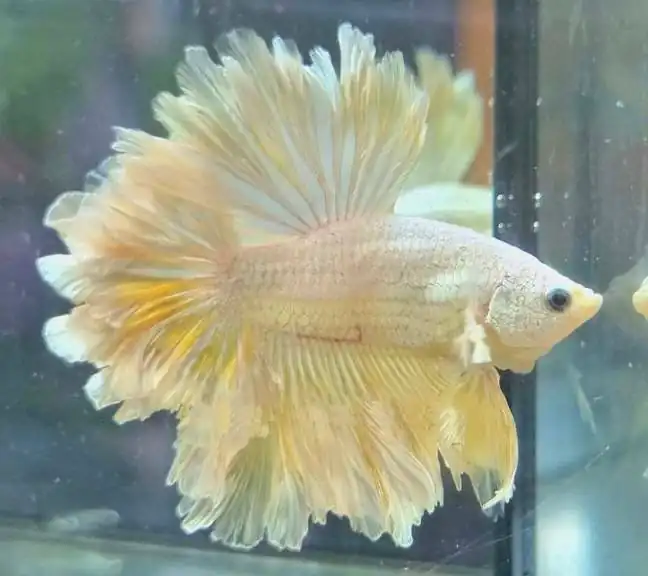
Rosetail fins are prone to fraying and are more susceptible to infections and injuries. Their delicate fins make it difficult for them to swim freely and reach the aquarium surface to breathe.
My rosetail had to struggle too much, even with a few inches, to get food. While it added elegance to my aquarium, maintaining its health required special care and attention.
8. Feathertail (FT)
Similar to Rosetail, feather tail is a mutation of the halfmoon with extreme branching and ruffling of fins, resulting in a feather-like appearance. This type of betta can have very delicate fins. The only difference between rosetail and feathertial is the ruffling of fins- the former has gentle and smooth ruffles, while the latter has distinct, feather-like ruffles.
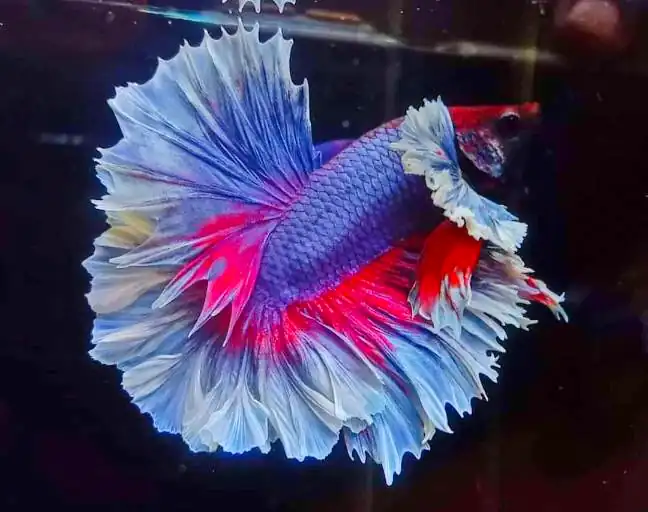
Despite their appealing appearance in pictures, it’s worth noting that neither trait is advisable to breed for. They are actually very difficult to take care of. Feather tail bettas can develop excessively large and heavy tails, which their bodies struggle to support. This can lead to problems such as tail biting and potentially fin rot, making the fish unattractive and unhealthy.
9. Dumbo or Elephant Ear
Dumbo, or elephant ear, bettas are a stunning and distinctive variety of betta fish characterized by their large, flowing pectoral fins that resemble elephant ears. Their caudal fins come in several types, such as veiltail, halfmoon, and plakat, showcasing a diverse range of appearances. Dumbo bettas exhibit a stunning array of colors and patterns, such as solid shades, captivating bi-color combinations, intricate marble designs, and a myriad of other captivating variations. They are active bettas and may interact more actively with their owners during feeding.
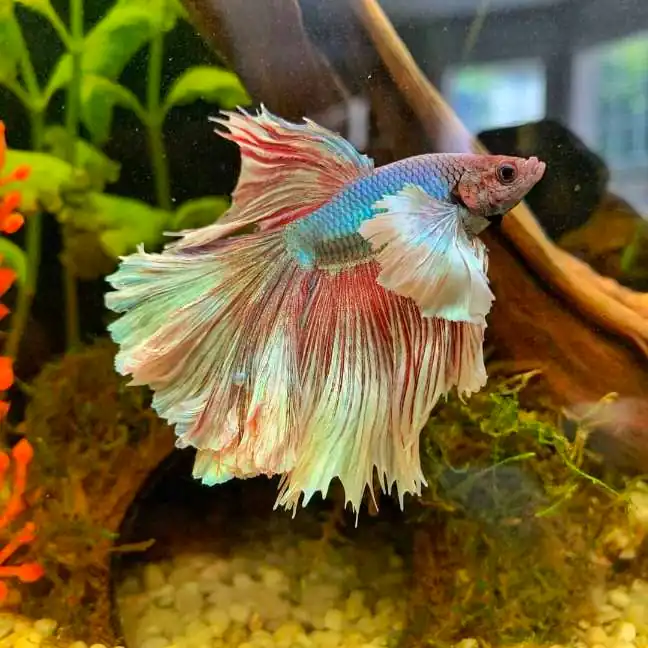
There is some debate over their care because of their large pectoral fins, which can be prone to injury and fin rot. Many betta keepers have reported fin-biting, but this might be normal behavior, as seen in other bettas. I have reared two dumbo females and never noticed them having difficulty swimming or fin biting. Their pectoral fins are located near the gills on either side, making it difficult for them to nip at their fins, as their heads cannot move that way. However, if there are any sharp decorations in your aquarium, these delicate pectoral fins can be prone to rupturing.
10. Round tail or Fan tail
Round tail bettas are a unique variety of betta splendens known for their round caudal fins. Their caudal fins lack the sharp edges or points as seen in other betta types like crown tails or veil tails. These types of bettas are less common, sometimes confused with short-finned females or plakats.
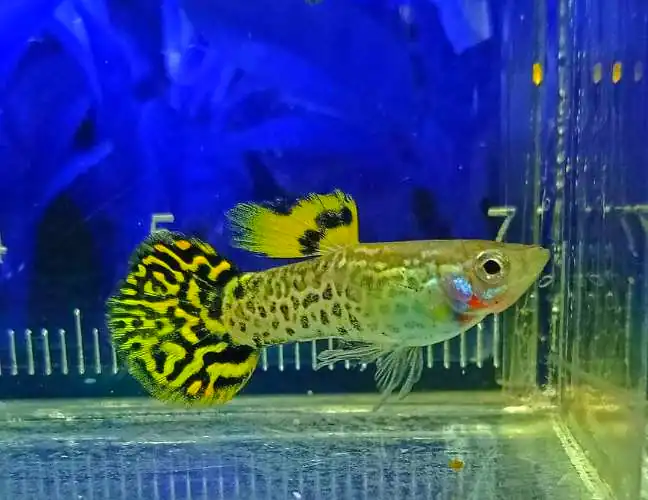
Short-finned Categories
These types of bettas have shorter fins compared to the traditional long-finned varieties. These bettas are healthier than long-finned bettas because their shorter fins put less stress on their body, and they have no difficulty swimming.
I’ve kept both long-finned and short-finned bettas, but I prefer the short-finned bettas as they are more active and friendly, and their fins are not too heavy to weigh them down.
1. Plakat (PK)
Plakats are the most popular category of short-finned betta fish that closely resemble wild bettas. They are known for their robust health and are not hindered by their fins like long-finned bettas. Plakats have compact fins, which make them excellent swimmers. They are closer to the natural type of bettas and are strongly recommended for beginners starting their betta hobby.
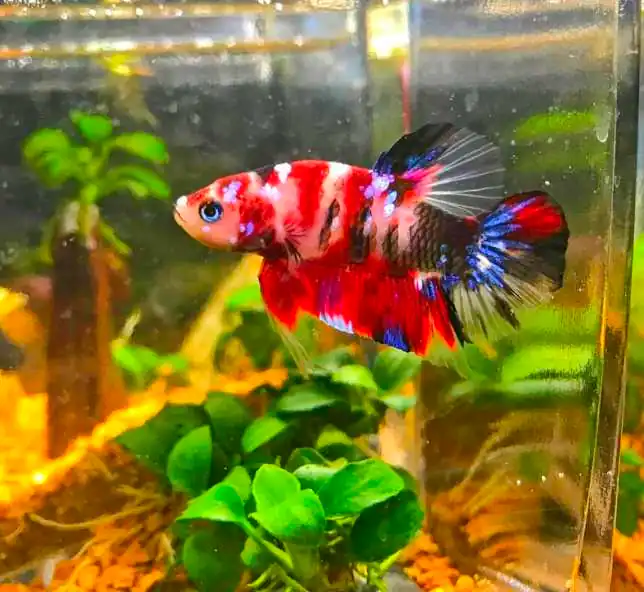
An interesting fact about plakats is that they are more social and interactive with their owners and other tank mates. Currently, mine is coexisting peacefully with a mystery snail and amano shrimp. Being having shorter fins, they are less prone to fin damage. Their males can be more aggressive.
They combine the beauty of various tail types with the practicality and health benefits of shorter fins, making them a popular choice among betta enthusiasts. Their sub-categories are;
i. Halfmoon plakat (HMPK)
ii. Crowntail plakat (CTPK)
iii. Double tail plakat (DTPK)
iv. Rose tail plakat (RTPK)
2. Spade Tail betta
The defining feature of spade tail betta is their tail which is broad at the base and tapers to a rounded point, similar to the spade symbol (♠). The tail is usually symmetrical and balanced, showcasing an appealing look. These bettas have also well-proportioned dorsal, anal, and pectoral fins. With proper care and attention, it can be a good addition to your aquarium.
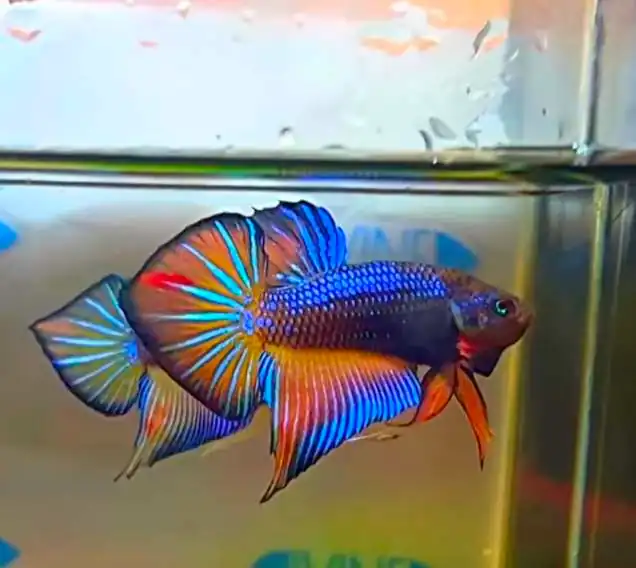
Types of Betta Fish Based on Color
1. Solid Color
Solid color bettas have uniform color across their bodies and fins, with hues ranging from vibrant and bold to softer, pastel shades. A lively and even color often indicates a healthy betta. Common solid colors include red, blue, white, and yellow.
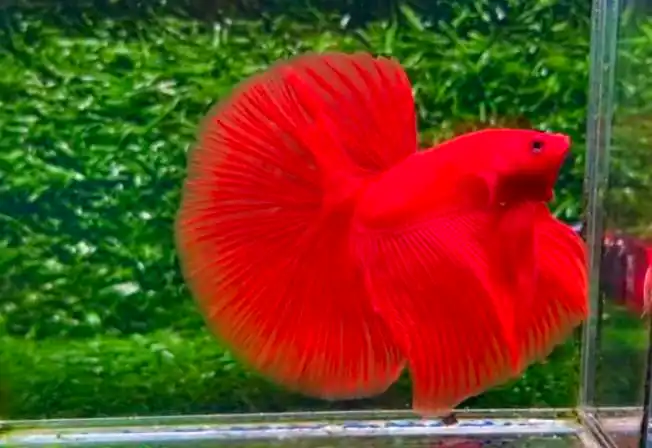
Solid red bettas lack pale or soft hues, while other colors, such as blue or yellow, may exhibit fading or iridescence on their anal fins. Because of this fading, the solid blue has further varieties of steel, royal, and turquoise. For example, solid blue bettas can vary further into shades like steel blue, royal blue, and turquoise due to this fading.
2. Bi-color
Bi-color bettas have two distinct colors on their body and fins, which are clearly defined and separated. The color combinations vary in contrast, featuring pairings such as red and blue, black and gold, or other combinations that highlight their bi-color appearance.
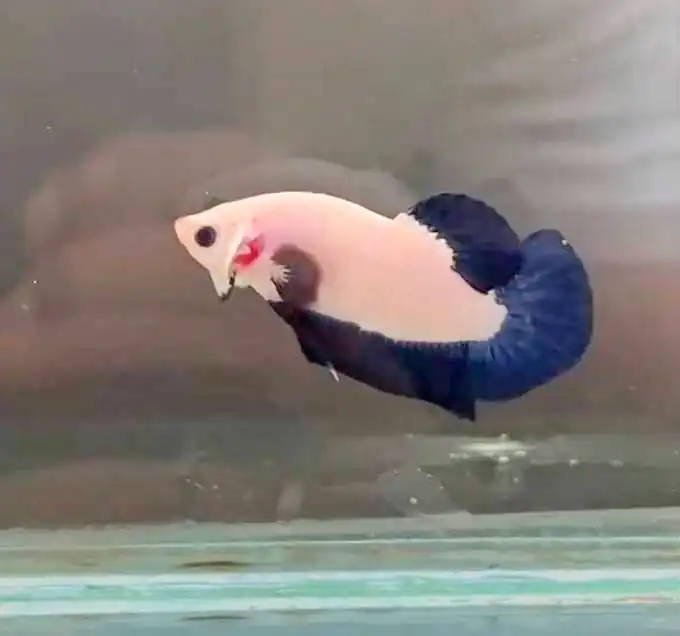
The Cambodian betta is categorized as a bi-color betta, characterized by a pale, flesh-colored body with vibrant, contrasting fins. It has white body with red fins.
3. Multicolor
These types of bettas display three or more distinct colors on their bodies and fins. They exhibit a mix of hues in various patterns and combinations, making each fish unique. They have often combinations of red, blue, black, white, yellow colors.
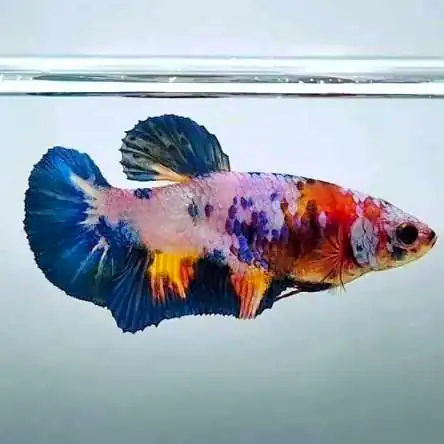
Types of Betta Fish Based on Pattern
1. Marble
Marble bettas resemble swirling marble patterns, with vibrant streaks and markings of various colors across their entire body. The splotches look like spilled paint or ink and can be large or small. This coloration is the result of a genetic mutation that causes irregular color patterns. As the betta matures, its marbling pattern may shift or change, leading to an evolving appearance.
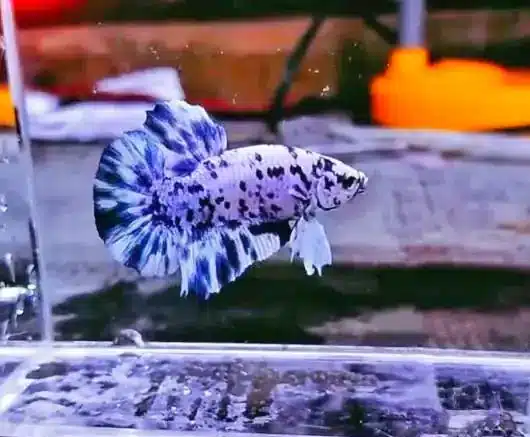
2. Butterfly
These bettas have a color pattern of contrasting shades, often with a darker edge or border around a lighter central area. This creates a striking “butterfly” effect resembling butterfly wings. Their body is typically of a solid color, while the wings feature bi-color bands, forming symmetrical inner and outer rings. The coloration of both their body and fins can be in any combination, though the blue-white combo is the most common.
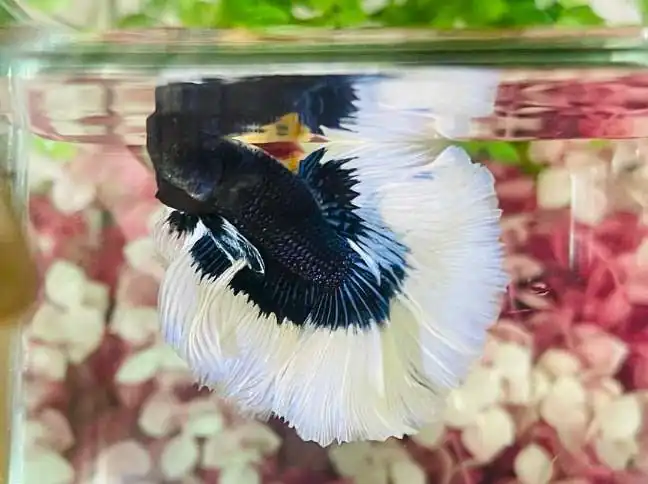
These bettas are all about looks and can add a fragrance of beauty to any tank. Just make sure their water stays clean to keep those vibrant fins in top shape.
3. Dragon
One of the most fascinating genetic types of betta fish, the dragon betta, is known for its thick, metallic, white scales on its body that look like dragon scales. This type of betta fish has gained significant popularity in the betta hobby over the past few years, particularly in Thailand and other Asian countries.
The dragon scale pattern was developed by crossing captive-bred betta splendens with a wild betta variety called mahachai. Dragon bettas come in various fin types and color variations, such as red dragon and black dragon. Despite having metallic scales, they don’t exhibit flashing colors; instead, they display thick scaling that resembles coppery, metallic dragon scales.
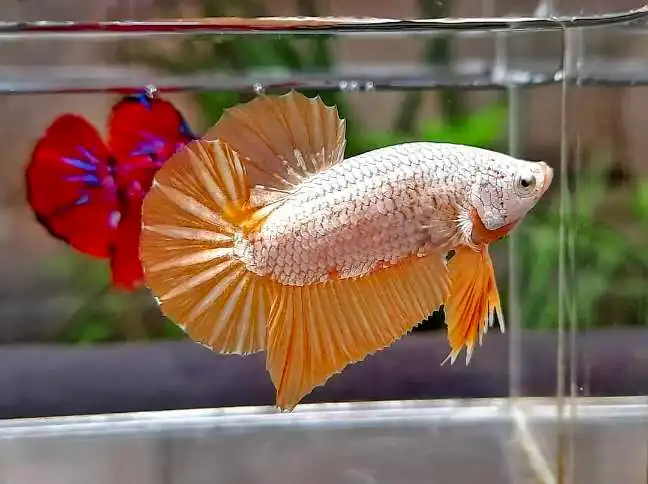
It’s important to note that dragon bettas with thick scale layers are more susceptible to developing diamond eyes and tumors, which can lead to blindness in the future. Due to these health concerns, dragon bettas often have a shorter lifespan, typically living for about a year in full health, so they are usually not recommended for keeping.
4. Cellophane
Cellophane bettas have clear or lightly colored fins and bodies accented with some color, giving them a translucent and glassy appearance. Their transparency is so remarkable that it sometimes allows visible internal organs to be seen.
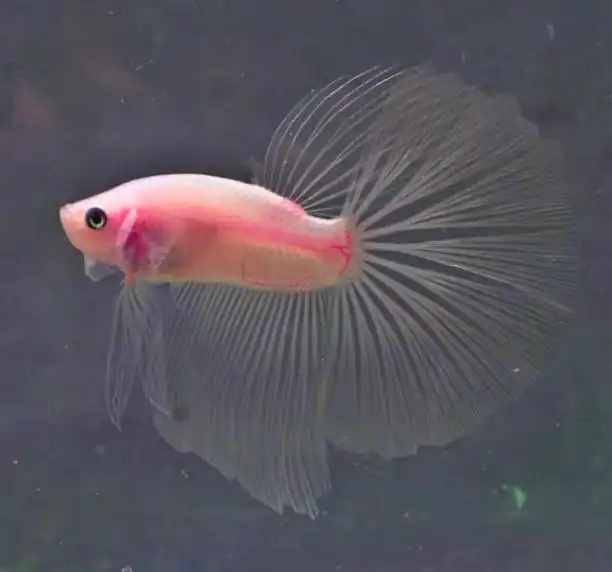
5. Dalmatian
The dalmatian betta fish is a unique variety of betta with an orange, pink, or apricot-colored body and orange fins adorned with dark red or orange spots. This pattern resembles that of a Dalmatian dog, which is how they earn their name.
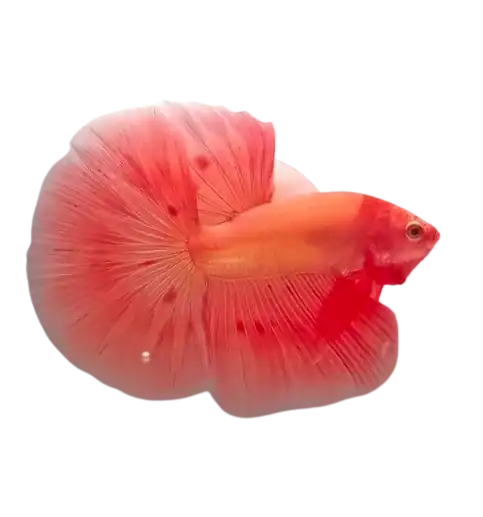
Difference between Dalmatian and Marble Betta
Most betta keepers confuse dalmatian bettas with marble bettas, but the two differ. Marble bettas have scars all over their bodies, including the fins, created by ‘jumping’ genes, while the dalmatian bettas have color patches only on their fins, caused by a specific mutation.
Marble bettas come in a wide range of colors due to these scars, whereas dalmatian bettas are typically found in shades of orange, light pink color, or, more rarely, blue.
These sternum betta fish gained popularity around 2004 and have been admired ever since, though they remain somewhat rare.
6. Koi Betta Fish
Koi betta fish have vivid, eye-catching colors with red, white, and black markings that resemble traditional koi fish designs. An interesting fact about koi bettas is their ability to change patterns over time due to a genetic trait called ‘marbling,’ which means their colors can shift or develop new patterns as they grow. The charming mix of red, orange, black, yellow, and white colors creates a dynamic and mesmerizing appearance.
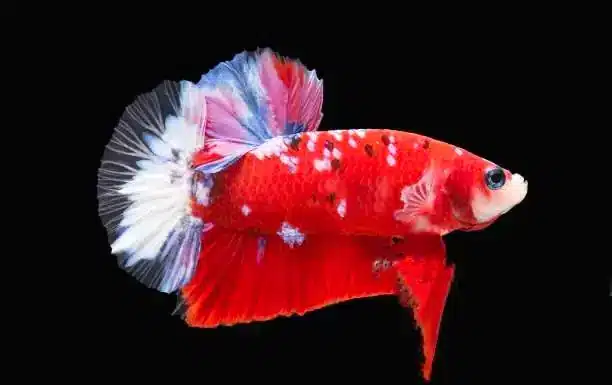
Like other traditional bettas, koi bettas have long, flowing fins and aggressive nature, making them best for solo or carefully managed community tanks. They are popular and more readily available types of betta fish.
7. Galaxy Betta Fish
Galaxy betta fish are often a type of koi betta variety, sharing the marbling gene that enables them to change their patterns and colors over time. Galaxy bettas typically have a dark base color, usually black or blue, with white, blue, green, or red specks resembling stars in the night sky. The size and density of the specks can vary, creating a unique and beautiful pattern. These bettas are highly coveted and more expensive due to their rarity and distinctive colors and patterns.
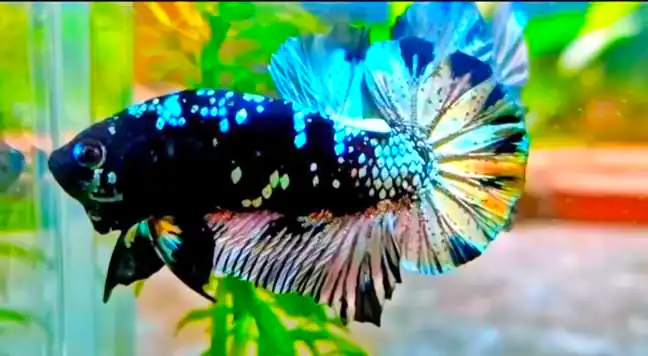
8. Grizzle Betta
Grizzle bettas have a cool, speckled look that makes them stand out more subtly. Instead of bold color patches, their scales are covered in tiny flecks that give them a dusted or frosty appearance—kind of like a light mist or sprinkle of color.
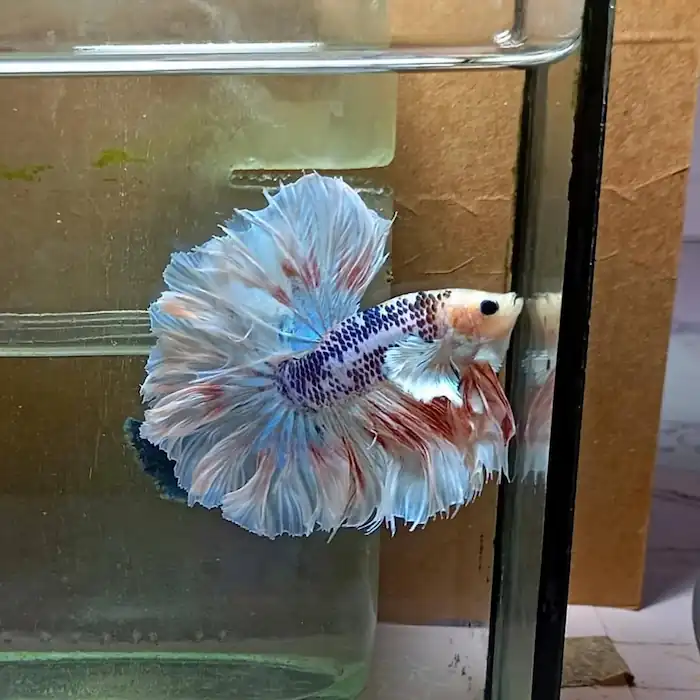
They often have a soft, greyish tone that adds to their unique charm. A grizzle might be the perfect pick for your tank if you like bettas with a more laid-back, artsy vibe.
9. Masked Betta
Masked bettas have a cool, uniform look because their face is the same solid color as the rest of their body. Unlike other bettas that often have darker or different-colored heads, these guys have a matching color from their mouth to behind their eyes. It gives them a clean, sleek appearance that really stands out—especially if the color is bold and bright. They’re a great choice if you like a betta with a smooth, all-over look.
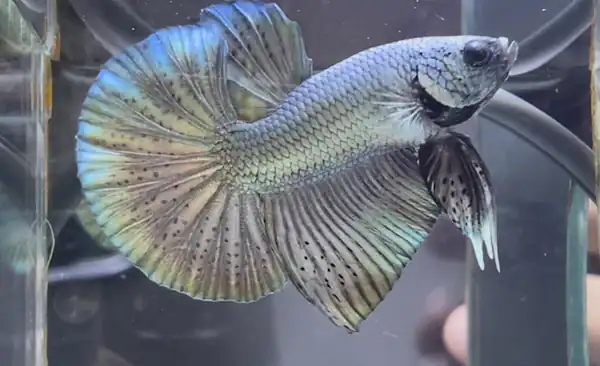
Choosing the Right Betta Type for You
Picking the perfect Betta isn’t just about looks—it’s also about finding one that suits your experience, tank setup, and how much care you’re ready to provide. Some Betta types are more beginner-friendly and hardier, while others need more attention due to their delicate fins or specific health quirks.
| Factor | Considerations | Example Betta Types |
| Experience | Beginner or experienced? Some Bettas are easier to care for. | Beginner: Veil Tail, Plakat Experienced: Halfmoon, Crowntail, Double Tail |
| Activity Level | Active swimmer or relaxed display? | Active: Plakat Relaxed: Halfmoon, Crowntail |
| Care Challenges | Some types have more health or fin issues. | Low risk: Veil Tail, Plakat Higher risk: Doubletail, Rosetail |
| Availability | Common types are cheaper and easier to find. | Common: Veil Tail, Plakat Rare: Rosetail, wild types |

